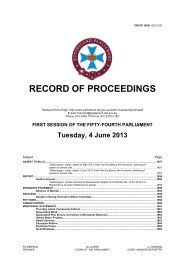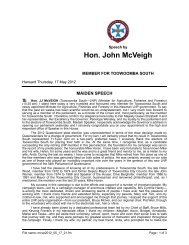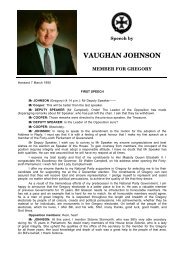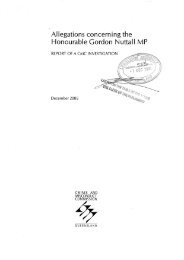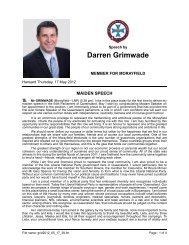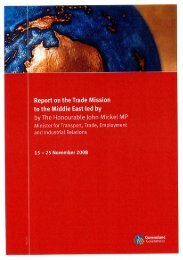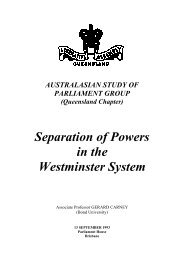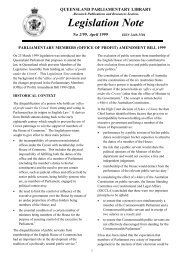RECORD OF PROCEEDINGS - Queensland Parliament ...
RECORD OF PROCEEDINGS - Queensland Parliament ...
RECORD OF PROCEEDINGS - Queensland Parliament ...
Create successful ePaper yourself
Turn your PDF publications into a flip-book with our unique Google optimized e-Paper software.
22 Apr 2009 Vegetation Management (Regrowth Clearing Moratorium) Bill 65<br />
outcomes. It does so firstly by introducing a moratorium on clearing more than a million hectares of<br />
regrowth vegetation in <strong>Queensland</strong>. During the moratorium, this bill extends the existing ban on<br />
broadscale clearing of remnant vegetation to now include important high-value regrowth vegetation.<br />
Specifically, the moratorium protects all native regrowth vegetation within 50 metres of a watercourse in<br />
the priority Mackay-Whitsunday, Wet Tropics and Burdekin reef catchments and endangered regrowth<br />
vegetation in rural areas across the state for a period of at least three months.<br />
During the recent election campaign, Labor committed to reducing the level of damaging<br />
pesticides and sediments flowing to the Great Barrier Reef. It is proposed to achieve this initially by<br />
restricting a combination of damaging farm practices such as overgrazing, tree clearing along creeks<br />
and excessive use of fertilisers. The provisions in this bill are the first step in meeting this election<br />
commitment and allow the government time to determine how best to achieve overall improvements to<br />
the health of the Great Barrier Reef.<br />
Effective from the start of 8 April 2009, the bill restricts the clearing of endangered regrowth<br />
vegetation on freehold and leasehold land in rural areas across the state. From 8 April the bill will also<br />
restrict the clearing of riparian regrowth vegetation that stands within 50 metres of a watercourse in the<br />
priority Mackay-Whitsunday, Wet Tropics and Burdekin reef catchments. These restrictions will apply for<br />
the period of the moratorium while the government consults on new longer term arrangements to protect<br />
high-value regrowth.<br />
It is important to note that the moratorium will not restrict clearing where there is an existing<br />
certified property map of assessable vegetation—a PMAV—showing an area of vegetation as a<br />
category X area. It will also not affect existing development approvals over the land where clearing is a<br />
natural and ordinary effect of the approved development.<br />
My department has already released a state-wide map, which is also produced at individual<br />
property level, showing the vegetation affected by the moratorium, including the watercourses identified<br />
within priority catchment areas. For the endangered regrowth protected under the moratorium, the maps<br />
have been made using the SLATS based science measure of foliage protective cover to show the<br />
regrowth that has a coverage that equates with the national standards used for both the Australian<br />
National Forest Inventory and the National Carbon Accounting System.<br />
To further assist landholders comply with the new provisions, a map of the Mackay-Whitsunday,<br />
Wet Tropics and Burdekin priority reef catchments will also be available on the department’s website<br />
once this bill is passed. These catchments have been identified as high risk due to their pollutant loads<br />
and proximity to the Great Barrier Reef.<br />
I will outline the current vegetation laws and the factors that have led to this moratorium to put the<br />
changes in this bill into context. The legislation I introduced in 2004 now protects all remnant vegetation<br />
from broadscale clearing. Remnant vegetation refers to vegetation that is mapped as remnant on<br />
regional ecosystem and remnant maps produced by the department. These are areas that are relatively<br />
undisturbed or that have been cleared previously and have regrown and recovered and are now similar<br />
to when the vegetation was in its original state. Regrowth vegetation is, under the Vegetation<br />
Management Act, defined as non-remnant vegetation. It is shown as white on the department’s regional<br />
ecosystem and remnant maps.<br />
Since this government ended the broadscale clearing of remnant vegetation in December 2006,<br />
the clearing of regrowth vegetation has continued on both freehold and leasehold lands. Only the<br />
clearing of some regrowth vegetation—that which has not been cleared for almost 20 years since 31<br />
December 1989 on state leasehold—is currently regulated. Data from the state-wide land and tree study<br />
report for 2006-07 released in February this year showed a substantial decrease in clearing rates and<br />
greenhouse gas emissions compared to previous reports, but the continuing rate of regrowth clearing is<br />
a concern.<br />
Clearing rates had dropped 37 per cent from 375,000 hectares in 2005-06 to 235,000 hectares in<br />
2006-07—the lowest rate of clearing since the first state-wide land and tree study, or SLATS study,<br />
reporting period nearly 20 years ago. Of the 235,000 hectares of woody vegetation cleared, 129,000<br />
hectares was remnant and 106,000 hectares was non-remnant regrowth vegetation.<br />
Clearing of remnant vegetation is mostly accounted for as clearing under the last of the<br />
broadscale permits in 2006 and clearing under established exemptions like roads, minor infrastructure<br />
and mining. However, the continuing high rate of clearing of endangered regrowth is a threat to<br />
biodiversity and allows for the continued release of significant levels of greenhouse gas emissions.<br />
Regrowth vegetation, particularly mature regrowth which has not been cleared for many years, contains<br />
many of the biodiversity and ecological values of remnant vegetation. Protecting endangered regrowth<br />
vegetation also helps to maintain and conserve regional ecosystem types with low coverage or high<br />
conservation values by assisting more areas to mature into remnant regional ecosystems.



